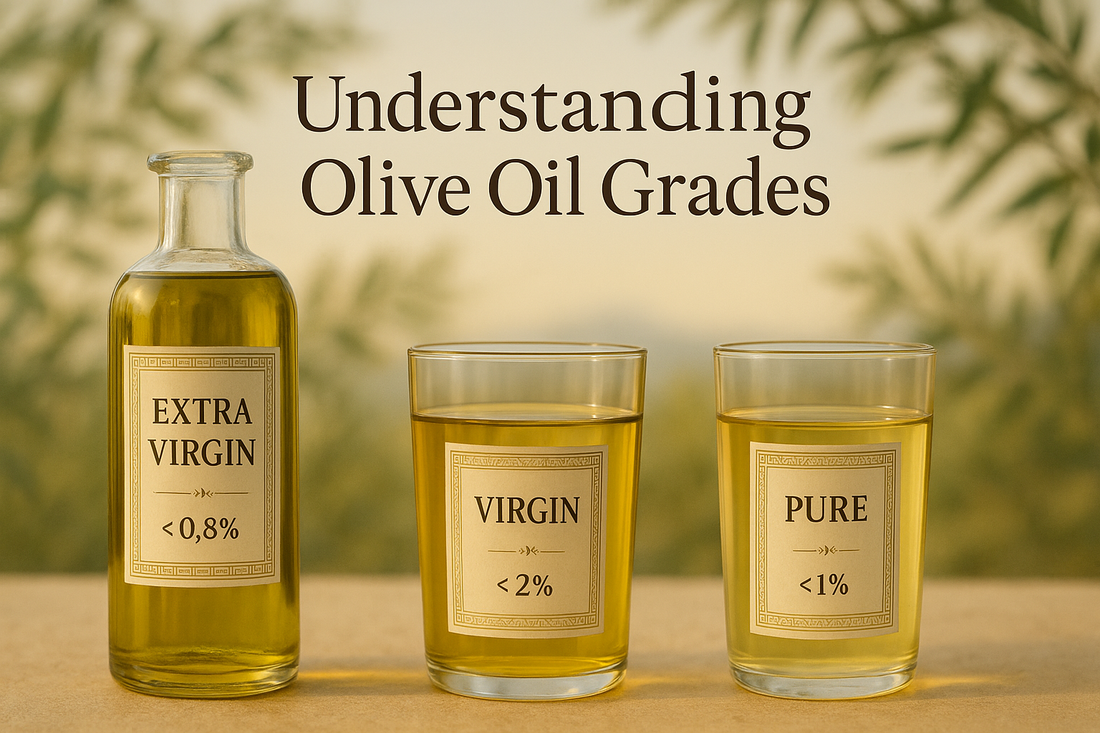
Extra Virgin vs. Virgin vs. Pure: Understanding Olive Oil Grades
The ancient Greeks called olive oil "liquid gold" – but not all olive oils are created equal. Understanding the differences between extra virgin, virgin, and pure olive oil is the key to unlocking the true treasures of Mediterranean cuisine.
When you walk down the olive oil aisle of any grocery store, you're faced with bottles bearing mysterious terms like "extra virgin," "virgin," and "pure." These aren't just marketing buzzwords – they're official classifications that tell the story of how the oil was made, what it tastes like, and how it should be used in your kitchen.
The Science Behind the Grades
Olive oil grading isn't arbitrary. It's based on two critical factors that determine quality: acidity levels and extraction methods. Think of acidity as the oil's report card – the lower the acid content, the higher the grade. But there's much more to the story.
Extra Virgin Olive Oil: The Crown Jewel
What makes it special: Extra virgin olive oil (EVOO) is the purest form of olive oil, extracted through mechanical means only – no heat, no chemicals, just the gentle pressure that releases the olives' natural oils.
The numbers that matter:
- Acidity level: Less than 0.8%
- Extraction temperature: Below 27°C (80°F)
- Processing: First cold pressing only
What your senses tell you: True extra virgin olive oil should have a vibrant, complex flavor profile. You might taste grass, herbs, pepper, or even a slight bitterness – these are signs of quality, not defects. The oil should smell fresh and fruity, never musty or rancid.
Best uses: Drizzling over finished dishes, salad dressings, dipping bread, or any preparation where you want the oil's flavor to shine. The antioxidants and polyphenols that give EVOO its health benefits are also what create its distinctive taste.
Virgin Olive Oil: The Reliable Middle Ground
What makes it different: Virgin olive oil follows the same mechanical extraction process as extra virgin but has slightly higher acidity levels, indicating minor defects in flavor or aroma.
The specifications:
- Acidity level: Less than 2%
- Extraction: Cold-pressed, no chemical processing
- Flavor: Milder than extra virgin, with some noticeable defects
The reality: Virgin olive oil is becoming increasingly rare in most markets. Many producers either achieve extra virgin standards or blend their oil into other categories.
Best uses: General cooking, light sautéing, and recipes where you want olive oil flavor without the intensity of extra virgin.
Pure Olive Oil: The Misunderstood Workhorse
The name game: Despite its name, "pure" olive oil is actually the most processed type you'll commonly find. It's a blend of refined olive oil and virgin olive oils.
What "pure" really means:
- Base: Refined olive oil (chemically processed to remove defects)
- Enhancement: Small amounts of virgin olive oil added for flavor
- Acidity: Less than 1%
- Flavor: Mild, neutral taste
The refining process: Pure olive oil starts with olives that don't meet extra virgin standards. Through chemical refining, heat treatment, and filtering, producers remove the defects – but also most of the flavor and many health benefits.
Best uses: High-heat cooking, frying, baking, and any application where you want the benefits of olive oil without strong flavor interference.
The Taste Test: What Your Palate Should Expect
Extra Virgin: Complex, sometimes peppery, with notes that might remind you of fresh grass, green tomatoes, or herbs. A slight burning sensation in your throat is actually a good sign – it indicates the presence of beneficial compounds.
Virgin: Milder than extra virgin but still retaining some olive character. The flavors are more subdued, and you won't get that peppery finish.
Pure: Neutral and mild, with very little olive flavor. It's essentially a cooking oil that happens to come from olives.
Reading Between the Lines: Label Secrets
Not all bottles tell the whole truth. Here's what to look for:
Harvest date matters more than expiration date. Fresh olive oil is better olive oil. Look for bottles that include the harvest year.
Origin stories: Single-estate or single-region oils often offer more consistent quality and traceable sourcing than blends from multiple countries.
Dark bottles protect quality. Light degrades olive oil, so quality producers use dark glass or tins.
Certifications add credibility. Look for PDO (Protected Designation of Origin) or organic certifications.
The Health Factor: Why Quality Matters
The health benefits you've heard about olive oil – heart protection, anti-inflammatory properties, antioxidants – are primarily found in extra virgin olive oil. The refining process that creates "pure" olive oil strips away many of these beneficial compounds.
Research consistently shows that the polyphenols in high-quality extra virgin olive oil provide the most health benefits. These same compounds are what create the oil's distinctive flavor and aroma.
The Greek Advantage
Greek olive oils, particularly those from Crete, benefit from ideal growing conditions, ancient cultivation methods, and varieties like Koroneiki olives that produce naturally low-acidity oils. Many Greek producers focus exclusively on extra virgin production, maintaining traditional methods that preserve the oil's natural character.
The Mediterranean diet's health benefits are closely tied to the consumption of high-quality olive oil – the kind that's been produced in Greece for over 4,000 years.
Your Next Step
Understanding olive oil grades transforms you from a passive consumer into an informed enthusiast. Start by tasting different grades side by side. Notice how extra virgin olive oil's complexity compares to the neutral character of pure olive oil. Once you experience the difference, you'll understand why olive oil quality matters.
Ready to experience the difference that true extra virgin olive oil makes? Explore our collection of premium Cretan olive oils, each one carefully selected for its exceptional quality and authentic Mediterranean character.
